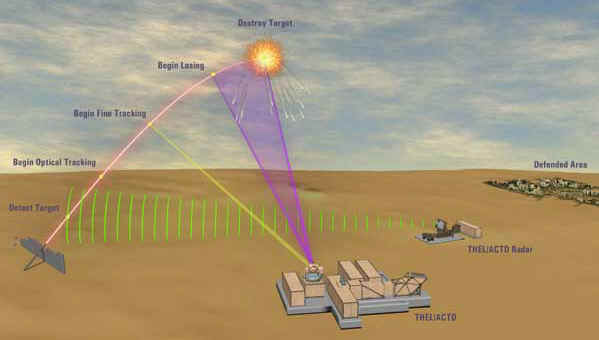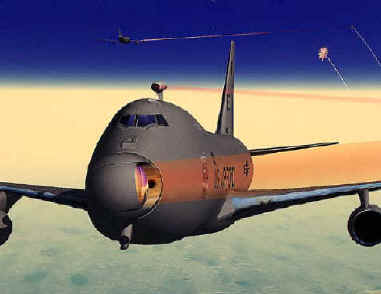The U.S. military is spending billions of dollars on laser research in hopes of developing a Star Trek like "phaser". This is an important area deserving research, however, billions will be wasted by deploying bogus systems. The biggest challenge is overcoming the limited range of modern lasers, which can only destroy unarmored targets less than 10 miles away on a clear day. This was proven with a September 22, 2000 test of the U.S. Army's Tactical High Energy Laser (THEL) at White Sands missile range.

The THEL is revolutionary, although major problems remain. The system is huge and not really mobile. In addition, laser beam power is greatly reduced by clouds and rain. Although these weapons have been sold as missile defense, they are truly the next generation in air defense. Even if they fail to burn up an aircraft, they can easily destroy sensors and blind pilots at great distances. More details about this ground based laser program is available at the TRW-THEL Website.
Unfortunately, TRW is not content with a few billion dollars for THEL, it has teamed up with Boeing to swindle taxpayers out of several billion dollars for an Airborne Laser (ABL) anti-missile system. Over one billion dollars has been devoted to the bogus idea that an ABL can shoot down missiles in the boost phase hundreds of miles away from a 747 flying at 40,000 feet. The Air Force has already built two ABLs in Boeing 747F airframes, and plans to purchase five more 747/ABLs after "successful" tests in 2003. More information can be found at the Boeing ABL Website .
 The only way the ABL will past testing is by
cheating. It cannot fire a stable laser beam strong enough to burn through
a missile casing more than a few miles a way. With such limited range, the Air Force
would have to maintain dozens of ABLs circling 20 miles apart over enemy
territory 24 hours a day to provide missile defense over a small nation. This would require
over 100 ABLs, 100 tankers, and total air superiority just to attempt to shoot
down a missile.
The only way the ABL will past testing is by
cheating. It cannot fire a stable laser beam strong enough to burn through
a missile casing more than a few miles a way. With such limited range, the Air Force
would have to maintain dozens of ABLs circling 20 miles apart over enemy
territory 24 hours a day to provide missile defense over a small nation. This would require
over 100 ABLs, 100 tankers, and total air superiority just to attempt to shoot
down a missile.
The major problem with range is that the Earth's atmosphere contains particles and moisture which reflect light, which is why the sky is blue, so laser beams quickly lose strength. Although the air is thin at 40,000 feet, an aircraft is not a stable platform which can focus the beam on a rising missile flying at MACH 2. Even at short ranges, the beam must focus on the same spot for several seconds to crack the casing; note the diagram above for a stable ground based laser. This is impossible since larger missiles often spin slowly, and missile makers may use stainless steel to reflect most of the laser beam. An AWACs airborne radar aircraft would prove far more effective firing longer range AMRAAM air-to-air missiles at rising ballistic missiles.
These are huge obstacles. The ABL scientists know this, but they enjoy their work and will be fired to telling the truth to the public. However, an Air Force Colonel, Neil McCasland, has admitted that a way must be found to "clean" the wavefront to avoid defraction of laser energy in the atmosphere. No serious proposals have emerged to overcome this reality. The ABL may be successful at shooting down incoming surface-to-air, air-to-air, and cruise missiles a few miles away. Therefore, the two ABLs already purchased should conduct testing as bomber escorts, but the idea of using the ABL for ballistic missile defense should be scrapped and no more 747-ABLs purchased.
Orbiting satellites have the stability to accurately fire lasers, but no one knows how to generate the necessary power for multiple shots. On the other hand, the U.S. Navy could greatly benefit from deploying defensive lasers to shoot down incoming missiles and aircraft. Ships can carry far more weight than aircraft and don't need to stay airborne to function. More importantly, ships are much more stable platforms because their movements are usually slow and predictable. There is no way to predict minor air turbulence that affects aircraft stability. Unpredictable air turbulence moving an airborne laser beam just one millimeter every microsecond causes the laser spot to move dozens of meters a hundred miles downrange. Laser research is important and will yield many new weapons, so long as funds are not squandered on more 747s for the Airborne Laser swindle.
Carlton Meyer editorG2mil@Gmail.com
Letters
Having worked on the ABL, I will tell you their only focus is getting the laser to fit inside a 747. No one believes the problems of defraction and stability can be overcome, but its interesting work.
Name Withheld
Update
Ed: Last June, I attacked the Airborne Laser program as a fraud (see Airborne Laser Swindle), noting the range needed is unachievable, and stabilizing the laser beam while airborne impossible.
Inside Missile
Defense - March 6, 2002
The Missile Defense Agency has moved a lethality test of the Airborne Laser,
originally scheduled for late fiscal year 2003, to the first quarter of FY-05 in
an attempt to lower program risk, according to an MDA spokeswoman and budget
documents. The lethality test is designed to prove ABL's ability to shoot down a
Scud missile-like target.
MDA recently assumed management of the program from the Air Force, which has consistently said the program was on track for the FY-03 test. MDA spokeswoman Maj. Catherine Reardon told Inside Missile Defense March 5 that when MDA took control of the program, officials decided to lengthen the overall ABL program schedule "because our philosophy is we want to provide lower risk and higher-confidence schedules for all of our missile defense programs."